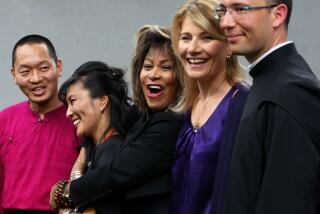Buddhist Group Beset by Membership Drop, Tension Between Sexes
- Share via
SAN FRANCISCO — Since it was established here 97 years ago, the Buddhist Churches of America has provided cultural shelter--and a religious foundation--to four generations of Japanese Americans.
At the group’s religious center has been Japan’s Jodo Shinshu Buddhism--an Americanized version of Zen Buddhism. But the group’s cultural offerings--its sponsorship of a wide array of activities, from youth sporting events and dances to ladies auxiliaries--are what enabled older Japanese Americans to hang together in their adopted country.
With 60 temples throughout the nation, the BCA has long been the best organized Buddhist organization in the United States.
But now, three years shy of its centennial celebration, the group’s future is clouded by declining membership, an unmet demand for doctrinal reform and a simmering war between the sexes.
Membership has dropped significantly as congregants died, intermarried or drifted away. In 1960, the BCA claimed 50,000 families. By 1977, that number had plunged to 21,600. And last year, membership dropped another 22% to 17,755 families.
That membership attrition has prevented a growing number of churches from making annual apportionment payments, the funds that uphold much of the BCA’s budget. And some, such as the 81-year-old Bakersfield Buddhist Church, have been forced to close.
Younger ministers blame the membership problems on the reluctance of the church’s aging leaders to update doctrines and policies to make them relevant to third- and fourth-generation Japanese Americans. Women complain that the male-dominated hierarchy is insensitive to their desire to become equal partners in church affairs.
In 1994, the claim of male insensitivity escalated into a sexual harassment lawsuit. The church’s director of Buddhist education in San Francisco, the Rev. Carol Himaka, charged another minister with making a series of crude, sexually explicit phone calls. She sued the church after it allegedly ignored her claims. Both the church and the male minister have denied the charges, and the lawsuit was dismissed for a lack of evidence.
But BCA ministers and board members point to the Himaka case as the fault line along which decades of generational and gender tension have ruptured.
“This case is important because for the first time, the status quo is being challenged and the BCA can’t handle it,” said Lucy Hamai, a board member of the BCA temple in Berkeley. “This is a chance for us really to come out and change, and we’re not doing it.”
Founded in 1898 in San Francisco by Japanese missionaries, the BCA is the U.S. branch of Jodo Shinshu, a hybrid of Pure Land Buddhism and Japanese family rites dating to the 13th century.
Established by the Japanese monk Shinran (1173-1263), Jodo Shinshu departs from traditional Mahayana Buddhism--the “middle way,” which emphasizes meditation and the practice of compassion to achieve enlightenment.
Shinran, who sought a Buddhism that could be practiced by ordinary people as well as religious ascetics, advocated that Buddhist monks be allowed to marry and taught that enlightenment comes after rebirth in the “Western Pure Land,” a state achieved by calling on the name of Amida Buddha and relying on his grace for deliverance.
But to many Japanese Americans, Jodo Shinshu has become stale, better known for its ritual commemoration of dead ancestors than for its doctrine of salvation by grace. And contact with American culture--one with little reverence for ancestral lines--has estranged younger Japanese Americans from the rituals and ideas their forebears transplanted into the “North American Buddhist Mission.”
Some ministers, such as the Rev. William Masuda, pastor of a BCA temple in Mill Valley, Calif., see openness to non-Japanese members as the key to saving the group from irrelevance by restoring its coffers and revitalizing church doctrine.
Today, as many as 70% of Japanese Americans are marrying outside the community, opening the door for many non-Japanese to become church members. But few join, some critics say, because the message of the church doesn’t draw them in.
More to Read
Sign up for Essential California
The most important California stories and recommendations in your inbox every morning.
You may occasionally receive promotional content from the Los Angeles Times.













